 Johanna Fateman
Johanna Fateman
Death and taxonomy: twenty-one photographs reflect on life and order in the Anthropocene.
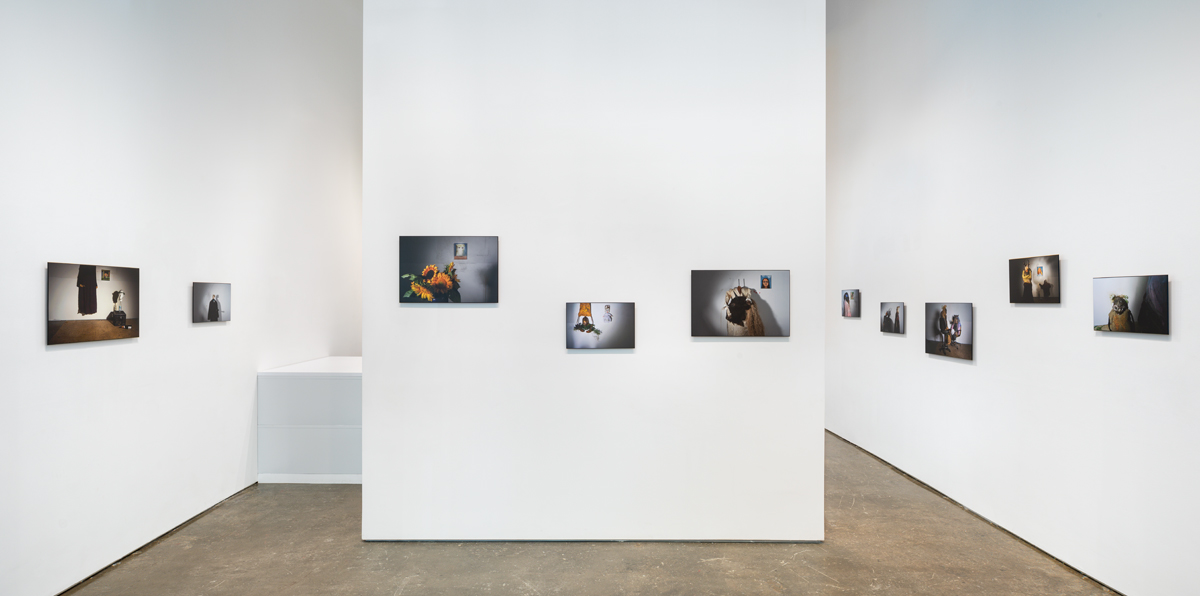
Claire Pentecost: Linnaeus After Dark, installation view. Courtesy the artist and Higher Pictures. Photo: Nick Knight.
Claire Pentecost: Linnaeus After Dark, Higher Pictures, 16 Main Street, Ground Floor, Brooklyn, NY, through September 30, 2023
• • •
While crowded still lifes—skulls, clocks, flowers, dripping candles, and the trappings of wealth, carefully arranged to represent the transience of life—come to mind first when I think of the vanitas, seventeenth-century Dutch practitioners of the opulent genre explored their theme in portraiture, too. Famously, the blithe subject of Frans Hals’s Young Man with a Skull (1626–28), an enormous pink feather in his beret and his face in portentous half-shadow, holds the macabre prop of the work’s title in his hand. The artist captured him mid-sentence, it appears, frozen in a show-and-tell pose.

Claire Pentecost, Ritual Evaluation, 2022–23. Pigment print, 11 × 16 1/2 inches. Courtesy the artist and Higher Pictures.
With her new exhibition, at Higher Pictures, of small, dimly illuminated photographs, Claire Pentecost is perhaps an unlikely entrant into this tradition of the painted spiritual warning. But, in images that float between the categories of still life and portrait, that seem to hail from an indistinct past, no particular era, she favors a similar symbolic density. Taxidermized quarry conjoin with cast-off clothing, plant matter, toys, and mannequin parts to form the hybrid figures that star in her vignettes, recalling the decaying clutter of aristocratic décor. The absurd costumes and predicaments of her Frankenstein-ed protagonists evoke something akin to the moral peril of Hals’s vain young man (or that of any of us). And, echoing her Baroque precursors, Pentecost underscores that the end is nigh—or already upon us.
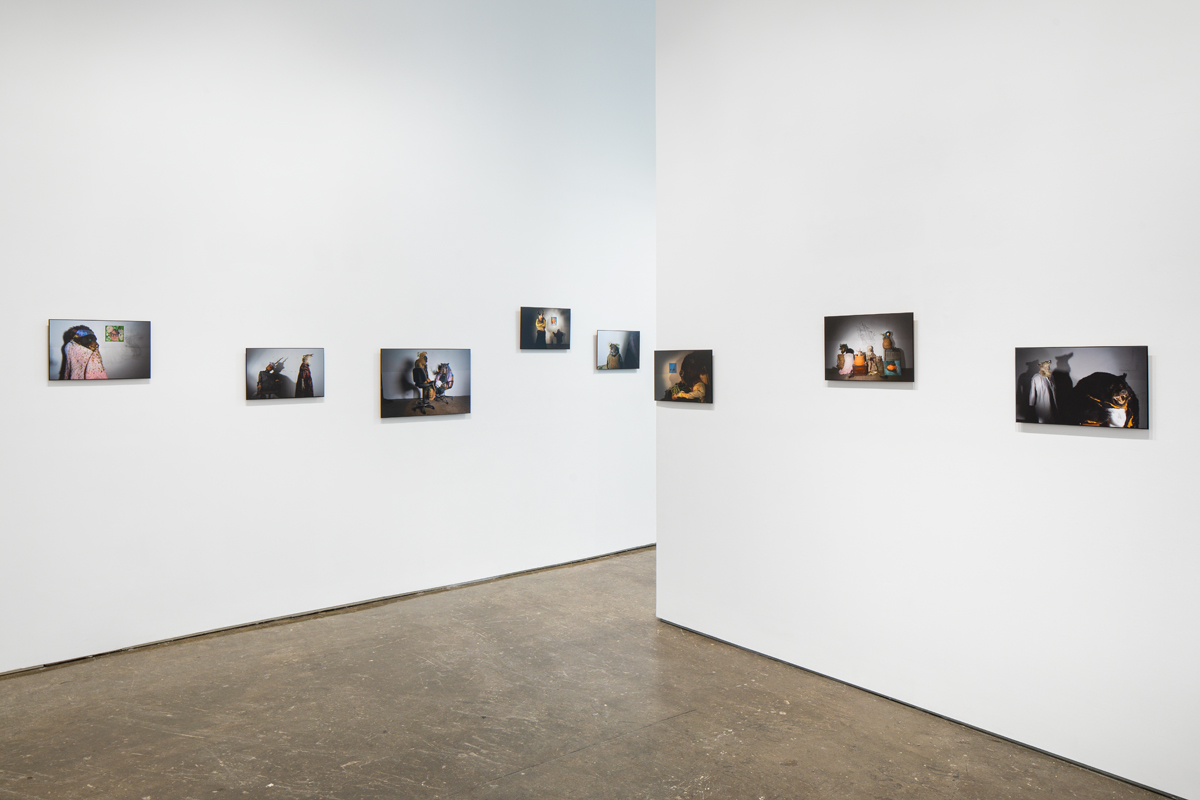
Claire Pentecost: Linnaeus After Dark, installation view. Courtesy the artist and Higher Pictures. Photo: Nick Knight.
Dead animals, disassembled into pieces, are a heavy presence in Linnaeus After Dark (as the 2022–23 series is titled), despite its sense of play. Whimsy and foreboding cross-fade in the shifting gloom. Hung at a range of eye levels in a wavy line around the compact gallery, the tragicomic interior scenes suggest an improvised mythic world—and a photo shoot of extremely scant resources. I imagine tilted table lamps, or work lights clamped to chairs, their weak beams carefully angled to achieve Pentecost’s range of low-tech effects. Distorted and amplified shadows have an outsize graphic and dramatic power, lending an etheric, metaphysical dimension to her yard sale– or garbage heap–sourced characters and sets. A makeshift staging of a fable, like a children’s play produced in a basement, comes to mind when, for example, in Ritual Evaluation, a bipedal coyote in a floral fast-fashion smock dress turns away from a legless, one-horned, bucket-masked creature slumped in an office chair. Pioneer Cemetery, on the other hand, is more in the spirit of Halloween. A decapitated frontier woman wears a gown of white damask, holding in her arms not a human head but one once attached to a beautiful bison.
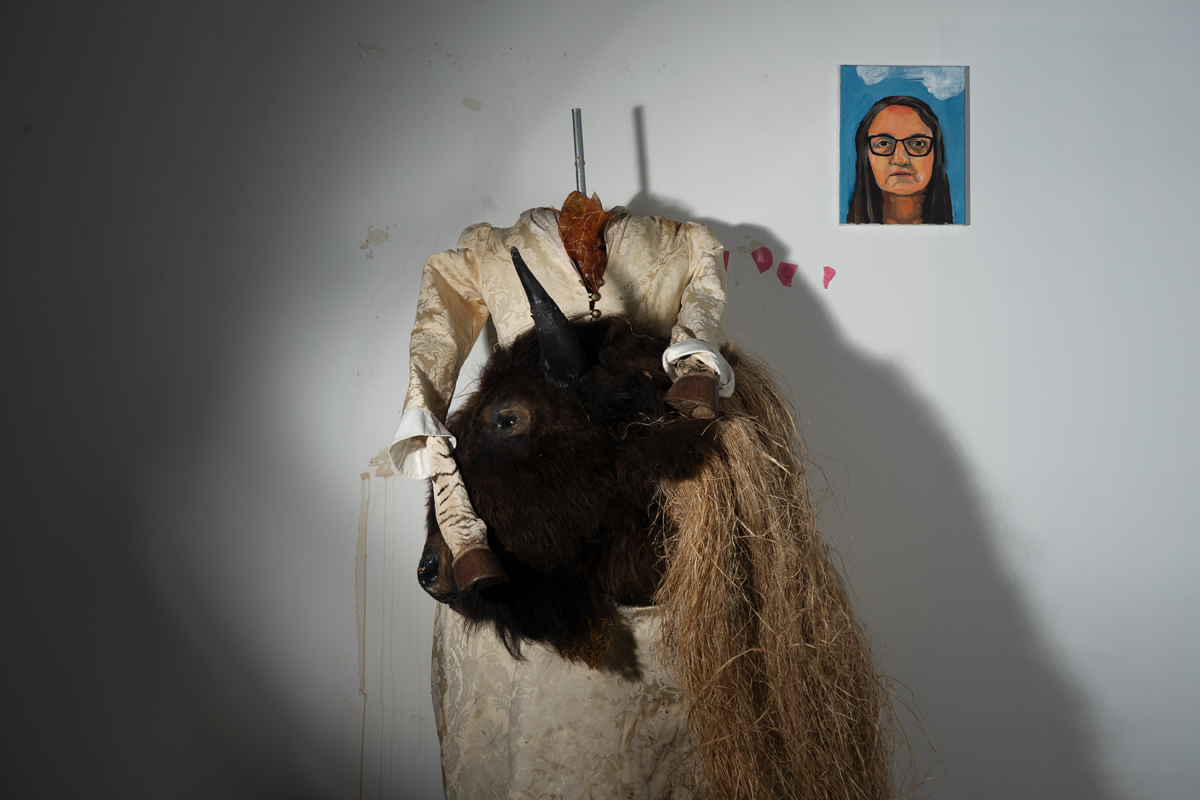
Claire Pentecost, Pioneer Cemetery, 2022–23. Pigment print, 16 × 24 inches. Courtesy the artist and Higher Pictures.
Behind this chilling apparition, mounted on a scuffed and stained wall (the artist’s sole backdrop), is a small canvas, a cropped portrait of Pentecost herself, it looks like, framed by blue sky. She often includes paintings within these compositions—another tendency, a winking meta-gesture, favored by the Dutch Golden Age. She is motivated by an ethic of self-implication, though. If the artists of the Protestant Reformation addressed, with the vanitas, a certain lack—new codes against idolatry forbade more dramatically seductive funereal scenes such as the Crucifixion—Pentecost alludes to the genre in her quest to solve a representational problem of our time. The old message of the memento mori, remember that you are going to die, aimed at the viewer’s individual soul, is inadequate to our earthly, interconnected, and interspecies fates as we suffer through the cataclysmic flameout of the industrial age.

Claire Pentecost, Sleuth, 2022–23. Pigment print, 11 × 16 1/2 inches. Courtesy the artist and Higher Pictures.
The series’s invocation of Carl Linnaeus, father of modern scientific taxonomy, points to another way of considering Pentecost’s pictures—as scrambled dioramas, comments on the killing, preservation, and display of animals as specimens or types. Donna Haraway, in her classic exegesis from 1984, “Teddy Bear Patriarchy: Taxidermy in the Garden of Eden, New York City, 1908–1936”—which details the creation of the American Museum of Natural History’s African hall, its deeply racist roots, and social purpose—points to the taxidermist Carl Akeley’s notion of photography as hunting with a camera. Behind the lens, Pentecost is doubtless attuned to the interchangeability or entanglement of the camera and the gun in the colonial aim to impose hierarchy and order.
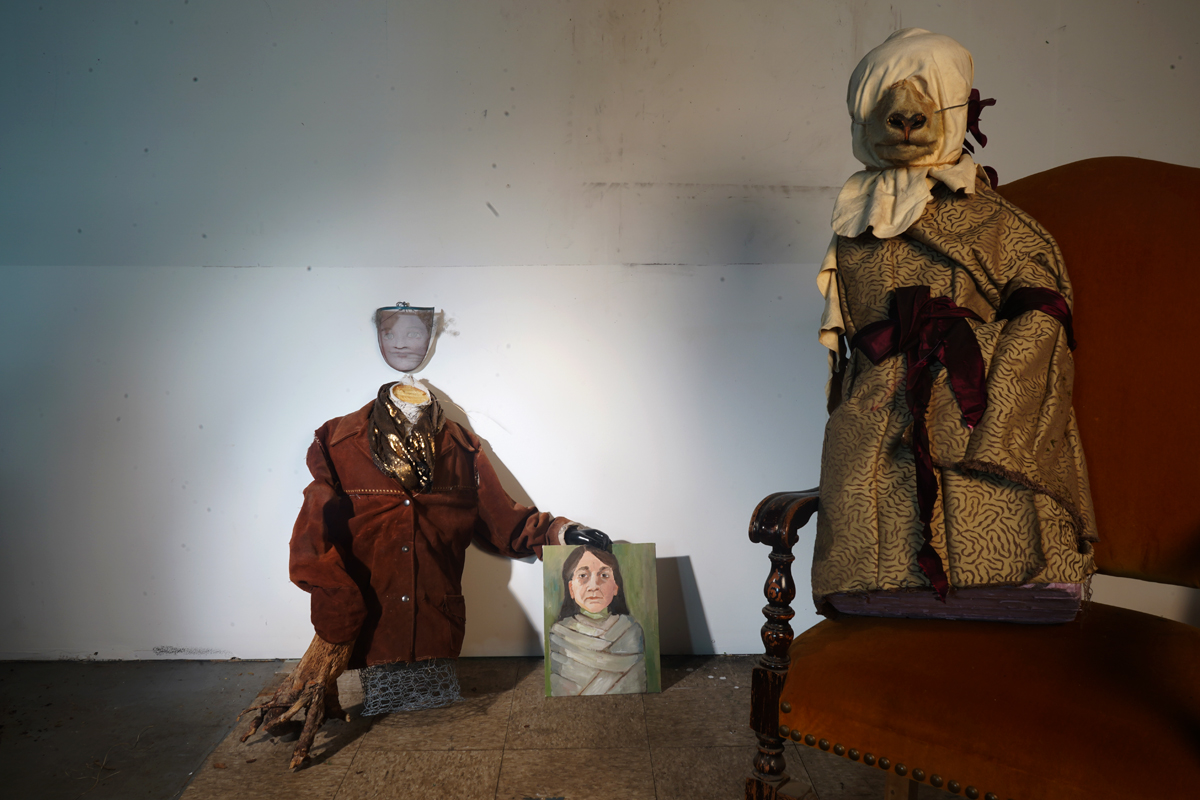
Claire Pentecost, Settler Colonial, 2022–23. Pigment print, 16 × 24 inches. Courtesy the artist and Higher Pictures.
The Chicago-based eco-conceptualist and proud “public amateur” has, in the past, taken her layperson’s research into such things as bioengineering, the industrial food system, and soil as the subject of her varied art. Here, though she cultivates mystery foremost, her calculated aesthetic of scavenged ferment points to the critical, activist content of the series, as do her titles. Mother, Sleuth, and the pointed Settler Colonial, among others, also suggest an archetypal significance, and with a total of twenty-one images, Pentecost is just a Fool or Hanged Man shy of a major arcana for a radical tarot. The shuffled arrangement of Linnaeus After Dark has no divinatory purpose, I don’t think, but rather is meant to reflect on, or undercut, destiny-making systems of classification and understanding, like the one—supposedly rational—pioneered by the show’s namesake.
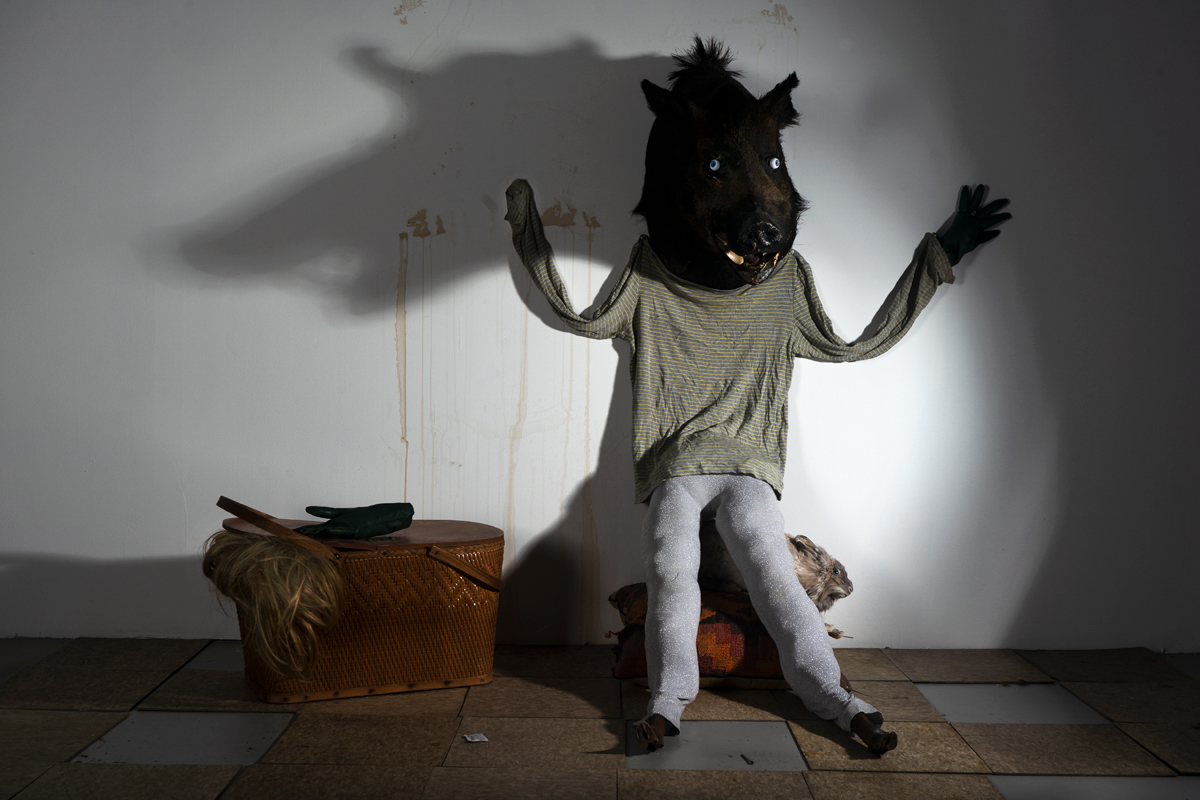
Claire Pentecost, The Winner, 2022–23. Pigment print, 16 × 24 inches. Courtesy the artist and Higher Pictures.
In the press release, Pentecost confides that her working title was The Persistence of the Unsorted, and in this light, you might see her sutured crossbreeds as insurgents rebelling against kingdom, family, and genus—the Linnean system that siloes organisms, severing them from their relational, ecospheric context, and which, historically, divided humanity into racial species. Also cast in doubt are traditional hierarchies of value. The Winner depicts a pitiable effigy, hardly victorious. A stuffed boar’s head with laser-blue glass eyes tops a “torso”—a wrinkled T-shirt whose sleeves are pinned to the wall in a pose of surrender. The beast has dropped a glove, perhaps in battle, and for legs it has lumpy stuffed sweatpants ending in hooves. Its prize, presumably, is concealed in a nearby picnic basket. Of the spoils, all we can see, spilling from under the lid, is part of the dirty-blond wig that resurfaces in Afterparty, on one of two deer-people who are engaged in a brawl, or a tryst, or are simply collapsed together on a dirty linoleum floor.
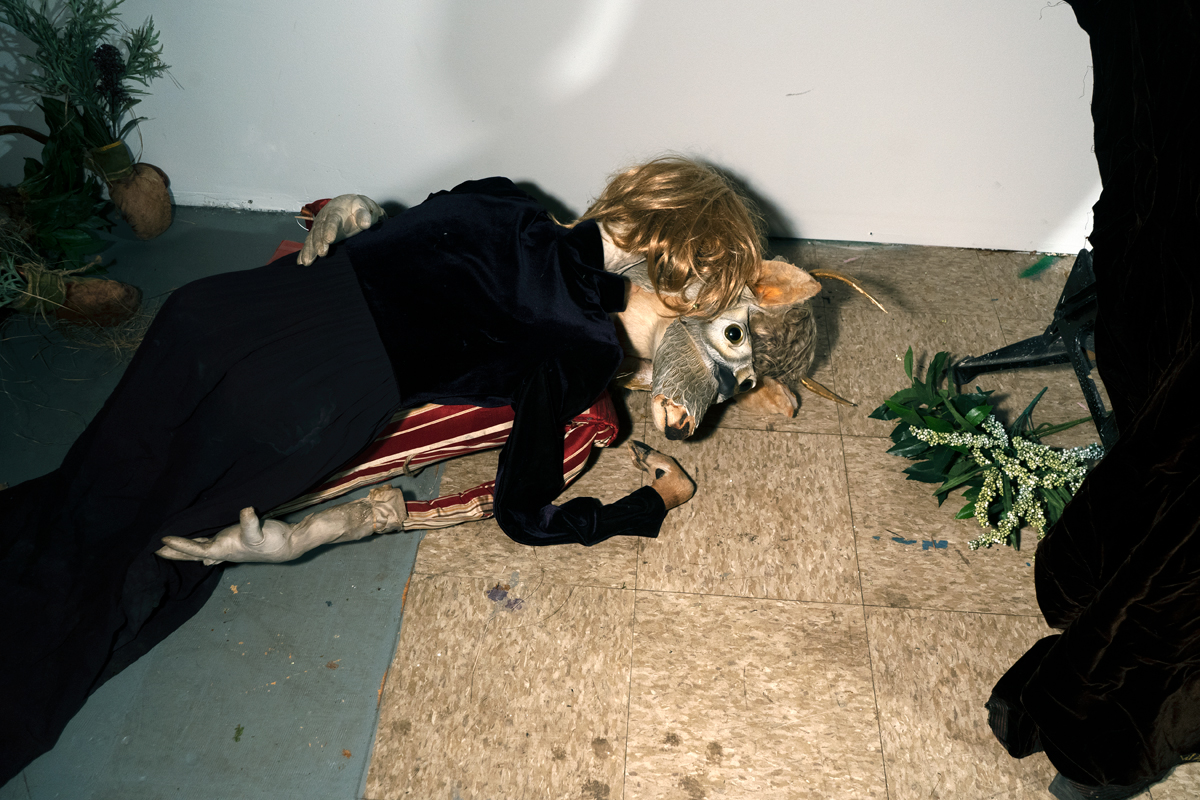
Claire Pentecost, Afterparty, 2022–23. Pigment print, 11 × 16 1/2 inches. Courtesy the artist and Higher Pictures.
Pentecost’s fantastic imagery is perhaps indebted to the ecofeminist surrealism of Leonora Carrington or the transcorporeal vision of Leonor Fini’s costumes and paintings. It reminds me of the enchanted and violent woodland scenes of contemporary sculptor Kathy Ruttenberg as well as the fraught surrogacy of dolls and ventriloquist dummies in Laurie Simmons’s photographs. But with its conceptual, crafty, provisional production values and its magnetically intimate scale, Pentecost’s striking body of work is unlike anything I’ve seen in recent days.

Claire Pentecost, Mother, 2022–23. Pigment print, 16 × 24 inches. Courtesy the artist and Higher Pictures.
It has a palpable if enigmatic theoretical mooring, and the look of a hermetic symbology, which the artist has decrypted elsewhere. In a lecture she delivered earlier this year (for a symposium titled “Genders of the Forests”), many of these photographs appeared as slides, forming a gorgeously creepy PowerPoint to accompany her script, a materialist-feminist treatise on posthuman interdependence. The presentation—watch it on Vimeo if you want to go deep—is a fascinating performance, though viewing it is not necessary to appreciate this show.
Pentecost’s fundamental message, while it is expansive, and could bear endless elaboration, is distilled in the unslick, remarkable images of Linnaeus. Or perhaps it’s more apt to say it is diffused. Layered, fugitive allusions and weird chiaroscuro foster voluptuous indeterminacy in these dioramic or painterly tableaux, which have much to say about sepulchral vanities, especially the quest to name and control.
Johanna Fateman is a writer, art critic, and musician in New York.